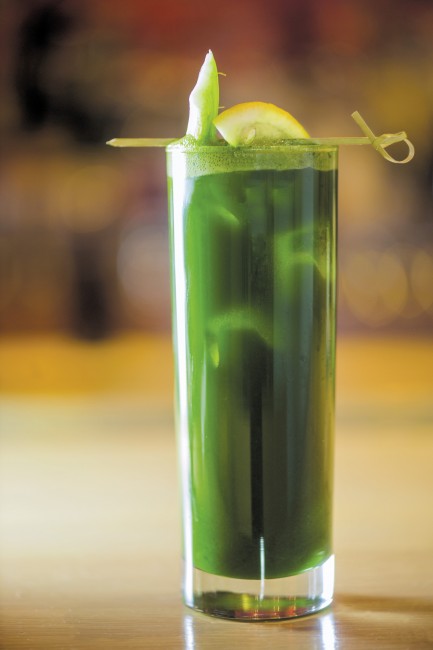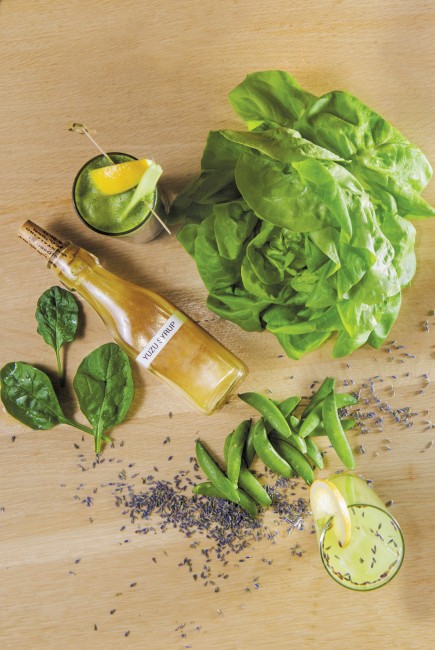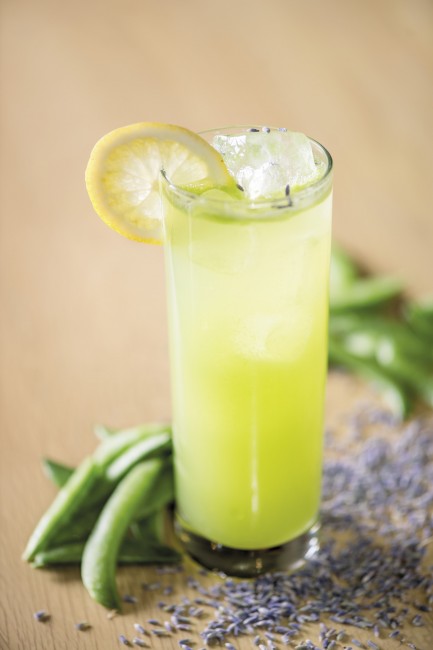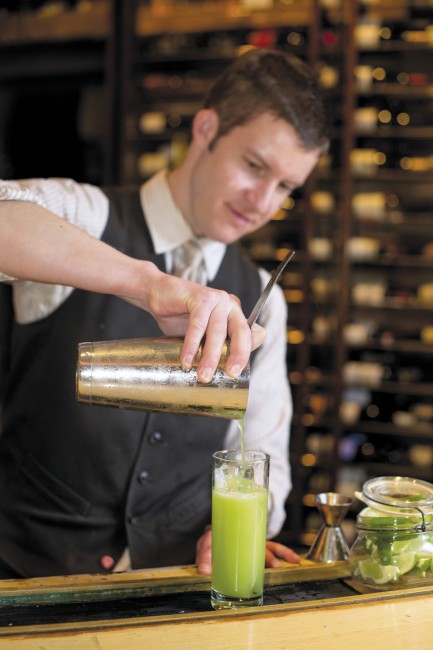Liquid Assets: At Rouge Tomate, Healthful Cocktails Are Not an Oxymoron

At Rouge Tomate, where gleaming two-toned hardwood floors, modernist banquettes and glowing tomato-red panels make everyone appear to radiate inner balance, you can — quite literally — drink to your health.
The specialty of the house, which opened in 2008 as an extension of Rouge Tomate Brussels, is health-giving food with an emphasis on fruits and vegetables, a menu that goes way beyond your garden-variety salad lineup, including dishes like an heirloom tomato and watermelon panzanella salad or guinea hen done three ways with fresh red plum reduction, foie gras and crispy sweet potato leaves.
A nutritionist on staff vets every recipe, looking for ways to lower sugar, salt and refined grains or add flavonoids that will unlock nutritional synergies. Founder and CEO Emmanuel Verstraeten has even developed his own certification and consulting arm called SPE, which focuses on nutrition and sustainability.
Yet despite all this, the vibe is less one of spa cuisine denial than of pleasure-seeking wellness. And that applies to the beverage program, too.
Last October, Rouge Tomate’s wine list tied with Gramercy Tavern’s in New York Times wine writer Eric Asimov’s ranking of the best in the city. Praising beverage director Pascaline Lepeltier’s “exquisite taste,” he called her list a “canny model of diversity” and an “unbelievably good world selection.”
Lepeltier’s mandate from Verstraeten, however, was not just to put together a dynamite wine list, but to add a strong bar program, too — something the Brussels restaurant, which opened in 2001, lacked, and that may initially have seemed at odds with a health-focused menu. Lepeltier, who came on in 2009, explains, “What I was hired for was to expand the philosophy of the food to the drinks.”
She has done exactly that.

To put produce at the center of the program, physically and philosophically, the restaurant’s first floor was designed around its juice bar, a small square room painted (naturally) tomato red. There, juicer Michael Vancott works full-time creating vegetable and fruit juices and purees for both kitchen and bar.
Tall clear bottles of head bartender Zachary Moore’s infused spirits line the walls, ranging from lavender rum, chamomile gin and fig shrub to kaffir lime leaf cachaça, habanero tequila and cask-aged Negroni. The sour mixes, syrups and sodas are made in house. And behind the bar stands a strong lineup of hyperlocal spirits, from Brooklyn’s Greenhook Ginsmith, Long Island’s Shinn Estates Vineyards and the Hudson Valley’s Tuthilltown Spirits. Brooklyn’s Uncouth Vermouth even creates several small-batch vermouths expressly for Rouge Tomate: crab apple-hop, raspberry and cherry, using wines of Red Hook Winery as their base.
Lepeltier assisted the restaurant’s first head bartender, Rainlove Lampariello, in developing a number of juices and nonalcoholic cocktails that express the essence of Rouge Tomate’s health-giving refinement: the Amber Palmer, a mix of jasmine and black teas, rosemary-grapefruit juice, mint and seltzer; and the Green Tornado, a gorgeous puree of tarragon, spinach, basil, butter lettuce, mint and lemon.
The program preceded the latest wave of the juicing boom, and offers way more than your standard juice bar fare: “These are nonalcoholic cocktails made to be as precise and balanced as any other cocktail,” says Lepeltier. “Most are stirred or shaken, using jiggers to measure, and meant to be drunk by themselves or paired with food. It’s not like just blending three different fruits.”
Rouge Tomate always offers 10 to 12 mocktails. Last year the runaway favorite was the Green Spring, a concoction featuring fennel, basil, lime, lavender honey and a cap of passion-fruit foam. Like many of Rouge Tomate’s mocktails, they can be easily converted into a cocktail, in this case with a shot of mango-infused vodka.

Working with the freshest ingredients isn’t as easy as opening a bottle. Molina says pulp made from strawberries that are “perfectly sweet and delicious” in May will have to be amended with lemon and sugar by August. Maintaining texture from drink to drink is also tricky, notes Moore: “It’s hard to get a good, consistent plum puree, because ripeness and sweetness can vary. It’s so fibrous, almost like baby food, so it can be hard to work with.”
But the benefits are well worth the trouble. The arrival of spring, says Molina (who stepped down from the head bartender position but is still involved with the restaurant), brings such an onrush of exciting produce that it can be overwhelming.
“There’s so much to play with,” he says. “Sometimes we’ll do 20 different drinks and then change them again. We’re lucky because whatever the chef [Jeremy Bearman] is using, we can use, too.”
A spring pea mojito features sugar snap pea puree, floral lavender rum, yuzu and Nikolaihof biodynamic elderflower syrup. Other elixirs-with-a-kick feature Szechuan buttons (small flowers that produce an explosive and slightly numbing sensation), fresh hops and ramps, and as spring turns to summer, donut peaches, watermelon, tomatoes, figs and corn, either pickled, pureed, juiced, infused or used as garnishes.
Moore cooks the peaches down to a concentrated consommé, which becomes the base for the Peach Pit Sour, which includes peach pit-infused Tuthilltown bourbon, lemon juice, bitters and egg white. The result is a beautiful, refreshing and frothy coupe of summer.
As new harvests arrive at the Greenmarket, they’ll offer a Manzanilla sherry cocktail muddled with raspberries, blueberries, Shinn Estate eau-de-vie and ginger syrup, and a tomato Old Fashioned made with Tuthilltown bourbon that’s been infused with spiced, slow-roasted tomatoes, muddled cherry tomatoes and orange slices, tangerine honey and bitters.

“We’re always trying to expand our field without being too esoteric,” explains Lepeltier. “In the end the drink needs to be good. Before we put one on the menu we’ll give regulars a shot, and say, ‘Do you think this is a crazy idea?’”
One crazy idea that quickly found favor is Moore’s Streetcorn Cocktail, inspired by his youth spent in Mexico City and its classic street food of grilled corn with lime, cayenne and Cotija cheese. His cocktail interpretation of this taste memory combines corn milk and mescal, rimmed with chipotle salt.
Yet there’s one thing that Molina, who grew up in palmy Ecuador, feels is missing at this urban oasis: “If you’re drinking a roasted rosemary Amber Palmer,” he says, “it would be great to have it outside. But we do our best; we have big plate glass windows.”
Photo credit: Cayla Zahoran

